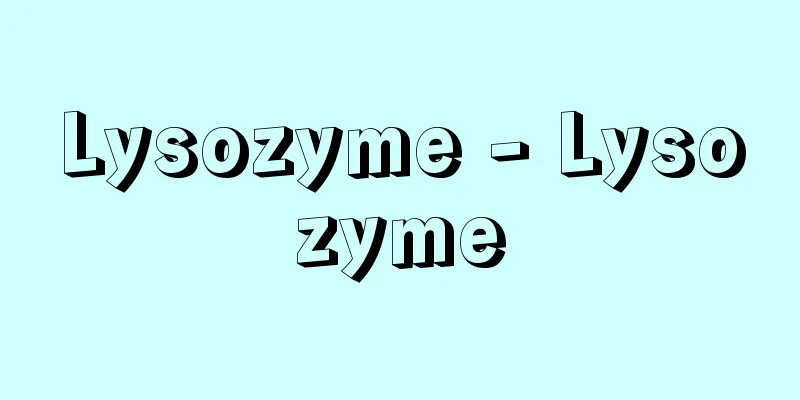Lysozyme - Lysozyme

|
Muramidase is an enzyme that hydrolyzes the β1-4 glycosidic bond (muramide bond) between N -acetylmuramic acid (NAM or MurNAc) and N -acetylglucosamine (NAG or GlcNAc) in bacterial cell wall polysaccharides. It is also called muramidase or mucopeptide glycohydrolase (glycoside is a broad synonym for glycoside). It is found in egg white, nasal mucus, saliva, tears, milk, blood plasma, urine, and in plants such as figs, papayas, and turnips, and plays a role in protecting the body from invading bacteria. It was discovered and named in 1922 by Fleming, a British man who was awarded the Nobel Prize in Physiology or Medicine in 1945 for the discovery of penicillin. He confirmed that there was a substance in nasal mucus and egg white that could dissolve certain bacteria, and named it lysozyme (pronounced lysozyme in English) because the bacterium Micrococcus lysodeiktics he isolated dissolved particularly quickly. It is said that this experience of discovery was useful in the accidental discovery of penicillin (1929). Later, lysozyme from chicken egg white was crystallized in 1945, and its amino acid sequence was determined in 1963. It is a single polypeptide chain consisting of 129 amino acids, cross-linked by four disulfide bonds. It has a molecular weight of 14,307 and an isoelectric point of 11.0, making it a strongly basic protein. The three-dimensional structure of NAM was first determined as an enzyme in 1966 by David Chilton Phillips (1924-1999) and others through X-ray analysis at a resolution of 1.5 angstroms (Å). The polypeptide chain forms an α-helix (one of the stable helical structures that a polypeptide chain can have) or a β-sheet structure (a type of secondary structure that proteins and polypeptide chains can have), forming a molecule with an almost ellipsoidal shape as a whole. The size is about 45 x 30 x 30 Å, and there is a long and narrow depression in the center of the molecular surface, where the substrate to be hydrolyzed fits into and is held by forming hydrogen bonds with the enzyme, distorting the boat-shaped structure of NAM to a half-chair shape. The cleavage of the β1-4 glycosidic bond is carried out by the cooperative action of two carboxyl groups (carboxyl groups) on the side chains of the 52nd aspartic acid and the 35th glutamic acid. In addition to bacterial cell walls, it also hydrolyzes chitin (NAG polymer) and NAG oligomers, and has transferase activity. Because its amino acid sequence is very similar to that of α-lactalbumin in milk, it is thought to have evolved from the same ancestral gene. The bacteriophage T4 , which parasitizes bacteria, also has lysozyme, and the sequence of its 164 amino acids has also been determined. It has been revealed that the gene encoding chicken lysozyme consists of four exons (base sequences that serve as blueprints for proteins) separated by three introns (intervening sequences, unnecessary base parts). [Koji Nomura] "Protein Design Using Genetic Recombination, edited by the Bio-Polymer Research Group of the Society of Polymer Science (1987, Society Publication Center)" ▽ "Protein Engineering, edited by Ono Shuichiro (1989, Maruzen)" ▽ "Miracle Drugs - Penicillin and the Fleming Myth, by Gwynne MacFarlane, translated by Kitamura Jiro (1990, Heibonsha)" ▽ "Functional Structure of Proteins, edited by Miura Kin'ichiro et al. (1990, Maruzen)" ▽ "Structural Biology, edited by Miura Kin'ichiro (1998, Asakura Shoten)" [References] | | | | | | | | | | bonds| | | | | | | | |Source: Shogakukan Encyclopedia Nipponica About Encyclopedia Nipponica Information | Legend |
|
細菌の細胞壁多糖類のなかでN-アセチルムラミン酸(NAMまたはMurNAc)とN-アセチルグルコサミン(NAGまたはGlcNAc)との間のβ(ベータ)1-4グリコシド結合(ムラミド結合)を加水分解する酵素で、ムラミダーゼmuramidaseあるいはムコペプチドグリコヒドロラーゼmucopeptide glycohydrolaseともいう(グリコシドは広義の配糖体と同義)。卵白、鼻粘液、唾液(だえき)、涙、乳汁、血漿(けっしょう)、尿のほか、イチジク、パパイヤ、カブなどの植物に含まれ、侵入細菌から生体を防護する役割をもつ。 ペニシリンの発見で1945年ノーベル医学生理学賞を受賞したイギリスのフレミングが1922年に発見し命名したもので、鼻粘液や卵白などに、ある種の細菌を溶解する物質のあることを確認し、彼が単離したMicrococcus lysodeikticsという細菌がとくに急速に溶解されることから、これをリゾチームと名づけた(英語読みではライソザイム)。なお、この発見の経験がペニシリンの偶然の発見(1929)に役だったといわれる。その後、1945年にニワトリ卵白のリゾチームが結晶化され、1963年にはアミノ酸配列が決定された。アミノ酸129個からなる1本のポリペプチド鎖で、四つのジスルフィド結合で架橋されている。分子量は1万4307で、等電点は水素イオン濃度指数(pH)11.0の強塩基性のタンパク質である。立体構造は、1966年フィリップスDavid Chilton Phillips(1924―1999)らが1.5オングストローム(Å)分解能のX線解析によって酵素として初めて決定した。ポリペプチド鎖はα(アルファ)-ヘリックス(ポリペプチド鎖がとりうる安定な螺旋(らせん)構造の一つ)やβ-シート構造(タンパク質やポリペプチド鎖がとる二次構造の一種)などをとりながら、全体としてほぼ回転楕円(だえん)体の形の分子をつくりあげている。大きさは約45×30×30Åで、分子表面の中央に細長いくぼみがあり、加水分解される基質はここにはまり込んで酵素と水素結合を形成して保持され、NAMの舟型構造はゆがめられて半椅子(いす)型になる。β1-4グリコシド結合の切断は、52番目のアスパラギン酸と35番目のグルタミン酸の側鎖のカルボキシ基(カルボキシル基)2個の共同作用によって行われる。 細菌の細胞壁のほか、キチン(NAGポリマー=重合体)やNAGオリゴマーも加水分解し、転移酵素としての活性もある。乳汁のα-ラクトアルブミンとアミノ酸配列がよく似ているため、同じ祖先遺伝子から進化してきたものと考えられている。なお、細菌に寄生するバクテリオファージT4も、リゾチームをもち、この164個のアミノ酸配列も決定されている。ニワトリのリゾチームがコードされている遺伝子は、三つのイントロン(介在配列。不要な塩基部分)が介在する四つのエキソン(タンパク質の設計図となる塩基配列)からなることが明らかになっている。 [野村晃司] 『高分子学会バイオ・高分子研究会編『遺伝子組換えを駆使した蛋白質デザイン』(1987・学会出版センター)』▽『小野修一郎編『タンパク質工学』(1989・丸善)』▽『グウィン・マクファーレン著、北村二朗訳『奇跡の薬――ペニシリンとフレミング神話』(1990・平凡社)』▽『三浦謹一郎他編『蛋白質の機能構造』(1990・丸善)』▽『三浦謹一郎編『構造生物学』(1998・朝倉書店)』 [参照項目] | | | | | | | | | | | | | | | | | | | |出典 小学館 日本大百科全書(ニッポニカ)日本大百科全書(ニッポニカ)について 情報 | 凡例 |
<<: Risorgimento (Italian: Risorgimento)
Recommend
Structuralism
Generally speaking, it refers to an ideological st...
Hiwaki [town] - Hiwaki
A former town in Satsuma County, central Kagoshima...
Nakagawa River
A river flowing east through central-southern Toku...
1 yen gold coin
…In May of the following year, a new currency act...
Cervantes - Miguel de Cervantes Saavedra
Spanish novelist, playwright and poet. [Kuwana Ka...
Kishiwada [city] - Kishiwada
A city in southern Osaka Prefecture. It was incorp...
Instrument of surrender
A document in which the defeated nation promises t...
Stone pavement (stone wall) - Ishidatami
…The original meaning of the word is a boundary s...
Oshima Strait
A strait between the main island of Amami Oshima a...
Zygopetalum mackayi (English spelling) Zygopetalummackayi
…[Koichi Ejiri]. … *Some of the terminology that ...
Iris wine - Ayamezake
〘Noun〙 Sake made by steeping cut roots and leaves ...
Sugi Ganami
Year of death: May 13, 1917 Year of birth: 1870 (M...
Ambiguous - Unclear
...The pass is the watershed of the Sasaya Highwa...
Ureaform - Ureaform
…Nitrogen is an important element for plants, con...
white
…In France, Babeuf had already opened up the theo...









